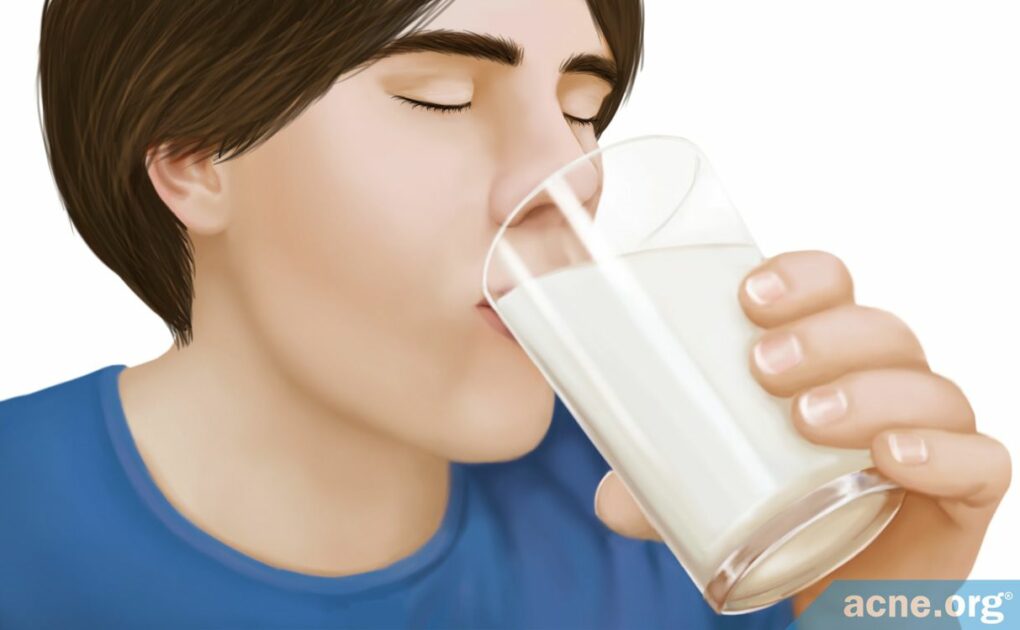Most Evidence, Albeit Imperfect, Points Toward a Possible Association Between Milk and Acne, but Not Cheese, and Probably Not Yogurt

The Essential Info
Researchers have put forward hypotheses that attempt to link the hormones, carbohydrates, and proteins in dairy with acne. However, studies investigating the relationship between dairy and acne rely on questionnaires, which are an imperfect method of obtaining data. Still, 13 out of 14 questionnaire-based studies thus far show an association between acne and at least some types of dairy in some people.
- Currently, most studies associate consuming milk to acne.
- On the other hand, cheese appears to have no effect on acne.
- When it comes to yogurt, the evidence is mixed, but it’s likely that yogurt is also safe for acne-prone people.
This remains an area of interesting debate, and hopefully in the future we will see randomized, controlled studies on dairy and acne so we can better determine if there is a link.
The Bottom Line: For now, if you want to be really careful, you might want to consider drinking less milk. When it comes to eating cheese and yogurt, there is probably no need to worry. But stay tuned here at Acne.org and I will keep you updated on any future developments.
My Experience: I’m a bit obsessive, so in my teens, every time I heard that any food was “bad for acne” I would avoid it entirely. This never led to clear skin, but did lead to social awkwardness and a generally less fun life. I ended up learning that just because there was a potential scientific association between some foods and acne, shunning those foods entirely didn’t give me the results I wanted. Moderation is key.

The Science
- Dairy & Acne Hypotheses
- Investigating the Link Between Dairy and Acne
- The Science: Dairy’s Effect on Chemical Processes in the Body and Acne Formation
- The Bottom Line
For years, researchers have studied the relationship between dairy and acne, and to date, evidence is mounting that there might be a connection. I put an emphasis on the word might because all of the studies performed thus far are questionnaire-based studies, which are notoriously imperfect.1
Several factors lead researchers to believe dairy might contribute to acne. According to authors of a 2014 article in the Journal of the Academy of Nutrition and Dietetics:
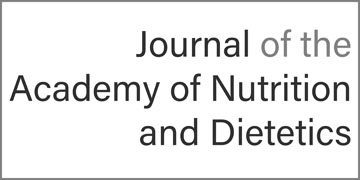
“Milk may contribute to acne development because of the hormonal, carbohydrate, or protein content. Milk contains a magnitude of hormones, including reproductive, nonreproductive, and growth hormones, which may individually or synergistically influence acne development.”2
Let’s discuss some ways hormones, carbohydrates, and proteins in milk might contribute to acne formation. Keep in mind that, at this time, there is no direct and compelling scientific support for eliminating dairy from the diet. The hypotheses below are simply initial thoughts that need to be tested.
Fair Warning: Deep science ahead, but dive in if you’d like and geek out with me.
Dairy & Acne Hypotheses
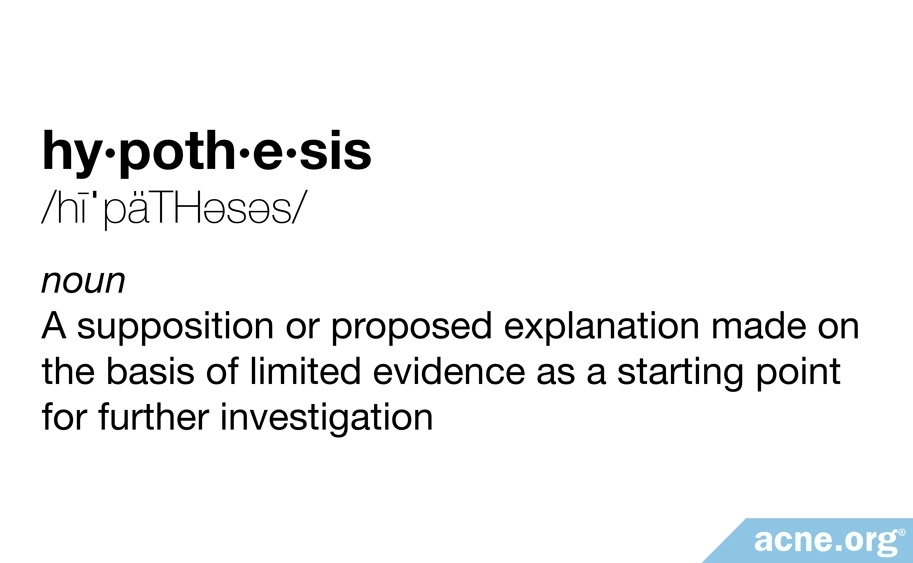
Milk Hormone Hypothesis: Hormones are signaling molecules that send messages to certain cells. Hormones found in milk, such as insulin-like growth factor (IGF-1) and the male hormone testosterone, might send messages throughout the body that lead to the development or worsening of acne.
- In acne, fat formation is important because skin oil is made from various fats. Sebaceous glands, which are located inside the skin’s pores, produce this skin oil. mTORC1 is a protein that stimulates fat formation. The hormone IGF-1 activates mTORC1. Higher levels of mTORC1 may increase the number of cells in the sebaceous gland and ultimately the amount of oil produced. These processes are known to cause or intensify acne.
- Male hormones are present in both males and females. Higher male hormone levels can lead to increased acne. The precursor to DHT can be converted to DHT, the primary acne-stimulating male hormone.
Milk Carbohydrate Hypothesis: Carbohydrates found in milk might cause the body to produce more insulin. In turn, insulin promotes overactivity of mTORC1, leading to acne formation or acne worsening.
Milk Protein Hypothesis: Whey and casein are the main proteins found in milk and both have growth-stimulating effects. Casein stimulates IGF-1 in the blood and whey promotes insulin secretion. Both IGF-1 and insulin contribute to mTORC1 overactivity, leading to acne formation or acne worsening.2
The image below shows how milk and dairy products may hypothetically lead to inflammation and acne production.3 Insulin and IGF-1 regulate certain proteins, such as mTORC1 and foxO1, which in turn affects another set of proteins, which go on to alter the fat formation in our skin cells. The resulting composition of fats forms the breeding ground for acne bacteria (C. acnes), which activate inflammatory molecules, triggering inflammation and breakouts.
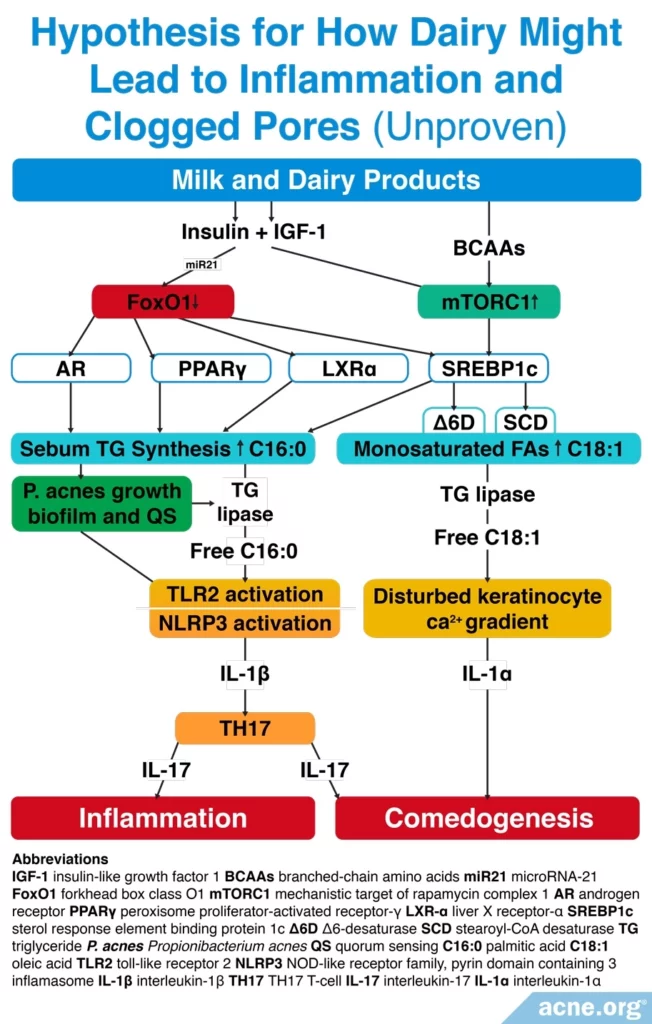
The Studies: Investigating the Link Between Dairy and Acne
In order to test the hormone, carbohydrate, and protein hypotheses, researchers would need to perform a type of study called a randomized controlled trial (RCT). RCTs are the most reliable type of study because they can prove whether one factor causes another–for example, whether dairy causes acne. To date, there have been no RCTs analyzing the effects of dairy on acne; therefore, researchers cannot conclude that there is a direct cause.
We do have some studies to look at, however. They are called observational studies, and are less reliable than RCTs. Observational studies, unlike RCTs, cannot test or prove hypotheses. In observational studies, researchers only describe what they observe. Surveys and questionnaires are examples of observational studies. Still, observational studies can provide some insight into the relationship between dairy and acne.
Three groups of researchers have conducted systematic reviews of the evidence, meaning they independently looked at all the available observational studies to come to an overall conclusion about dairy and acne.4-6 Let’s take a look at their findings:
- Milk consumption might contribute to acne: Two of the three groups of researchers concluded that consuming any type of milk, including whole, skim, or low-fat milk, might increase the odds of developing acne. The third group found the studies performed to date too contradictory to come to any conclusion regarding milk.
- Cheese is likely safe: All three groups of researchers agreed that eating cheese seems to have little or no impact on acne.
- Yogurt may also be safe: Two of the three groups of researchers concluded that eating yogurt appears to have no connection to acne. However, one group disagreed and saw a link between yogurt consumption and the chances of developing acne.
Interestingly, a fourth group of researchers recently looked at all of the available studies on dairy and acne, and found that:
- Dairy may trigger or worsen acne in young people from regions with a predominantly Western diet, such as the United States, but not in people from other regions.7
Why might dairy only trigger acne in young people in countries with a Western diet? There may be a few possible explanations:
- Perhaps the type of dairy products consumed in Western diets is more likely to trigger acne than the type of dairy eaten in non-Western diets.
- Perhaps the way dairy products are processed in countries with a Western diet makes them more likely to trigger acne.
- Maybe the seeming difference between countries with a Western and non-Western diet is simply a byproduct of flaws in the data from the various studies.
Expand to read details of systematic reviews
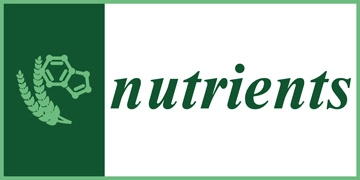
The first systematic review was published in the journal Nutrients in 2018.4 The review authors looked at all available research performed to date on dairy and acne. Initially, they found 241 observational studies, but many of the studies had serious flaws, leaving only 14 studies that were eligible for analysis. These 14 studies involved a total of 78,529 participants across five continents, including 23,046 participants with acne.
Summing up the findings of these 14 studies, the review authors concluded that consuming any yogurt or milk, including whole, low-fat, and skim milk, appears to increase the odds of developing acne. In addition, eating cheese seems to slightly increase the chances of developing acne. However, the review authors stressed that these findings should be interpreted with caution. They wrote, “There are many limitations of the included studies.”4
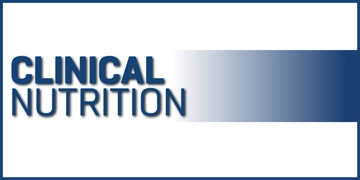
The second review was published in the journal Clinical Nutrition in 2019. This review was a meta-analysis, which means the researchers extracted and crunched the numbers from all the available studies to come to a conclusion about dairy and acne. They wrote, “In this meta-analysis we found a positive relationship between dairy, total milk, whole milk, low-fat and skim milk consumption and acne occurrence. In [contrast], no significant association between yogurt/cheese and acne development was observed.”5

The third review was published in Scientific Reports in 2020. The researchers examined 35 studies on how various factors, including dairy intake, might contribute to acne. They summarized their conclusions as follows: “Most studies found that cheese, yoghurt [sic] and ice cream intake did not significantly impact the risk of acne. The influence of milk intake on acne risk, however, was unclear, with inconsistent results between studies.”6
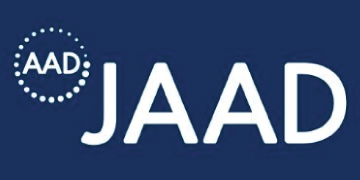
The fourth systematic review was published in the journal JAAD International in 2022. The researchers looked at 34 articles that investigated the link between acne and diet. They found that overall, dairy products seemed to be linked to acne in young people from regions with a predominantly Western diet, such as the United States and Europe. On the other hand, the researchers did not see a clear connection association between dairy and acne in young people living in regions with a predominantly non-Western diet, such as Asia. The scientists wrote, “Despite mixed evidence, we concluded that increased dairy intake may exacerbate acne among young people in nations with a prevailing Western diet, such as the United States, Europe, and Australia.“7
If you are curious to learn more about the observational studies these conclusions were based on, click to expand the section below.
Expand to see a summary of observational studies on dairy and acne
The table below summarizes the 14 observational studies included in the first meta-analysis.4 Of these 14 studies, 13 found a link between some types of dairy and acne.
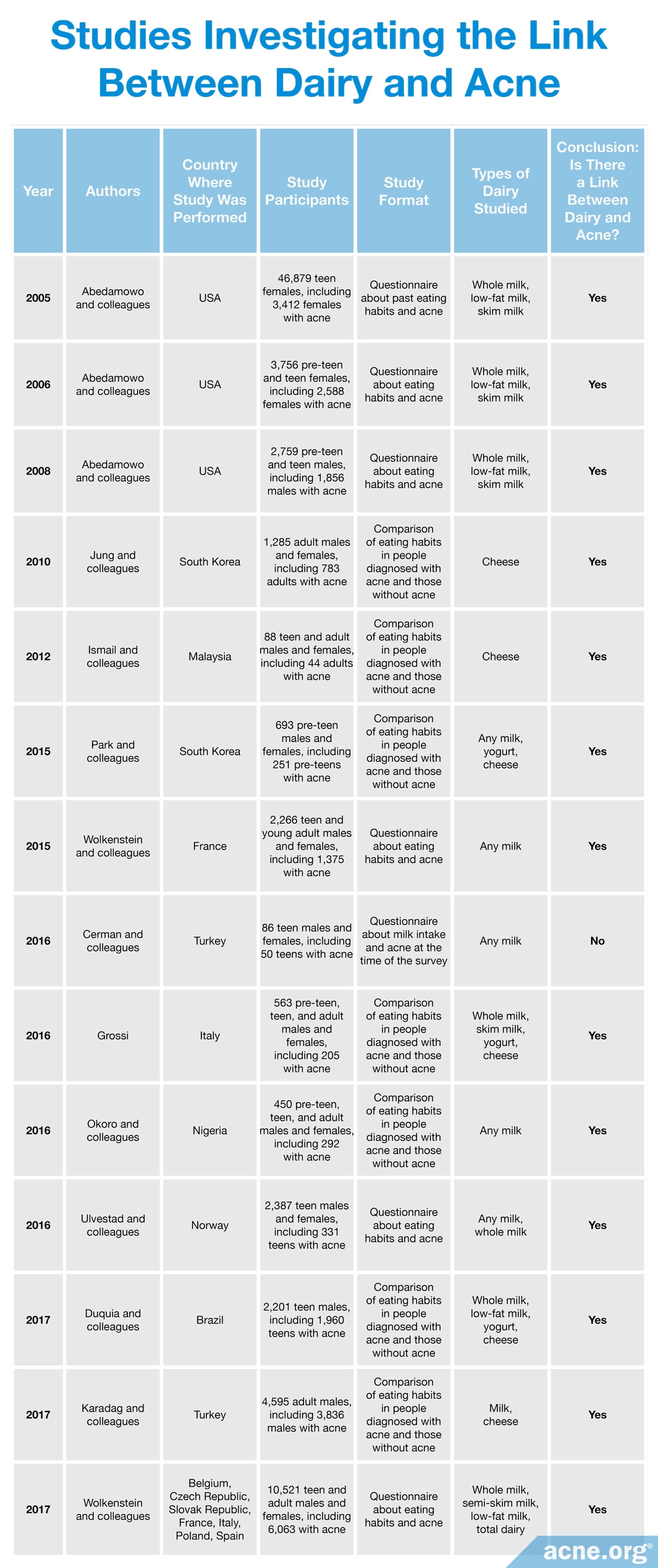
However, remember, because these studies are observational, they are not proof. Here are some of the limitations of the above studies:
- Questionnaires based on past habits require participants to remember and recall information. Some participants may not be able to recall accurately or may intentionally misreport information.
- Questionnaires are not always validated, which means that the questionnaire was not tested to see if the questions it contains will produce reliable answers.
- Cross-sectional studies, such as the one performed by Cerman and colleagues, only capture information about a specific moment in time. For example, participants were asked about their milk-drinking habits at the time. The questionnaires did not include questions about how much milk they drank in the past or about how much milk they planned to drink in the future. Cross-sectional study results do not provide insight into past trends, nor do they indicate what trends may be in the future.2,3,8-10
None of these studies are RCTs and, therefore, cannot establish whether there is a causal link between dairy and acne. The observational results, however, do tend to suggest that dairy intake may influence acne in some way.
The Science: Dairy’s Effect on Chemical Processes in the Body and Acne Formation
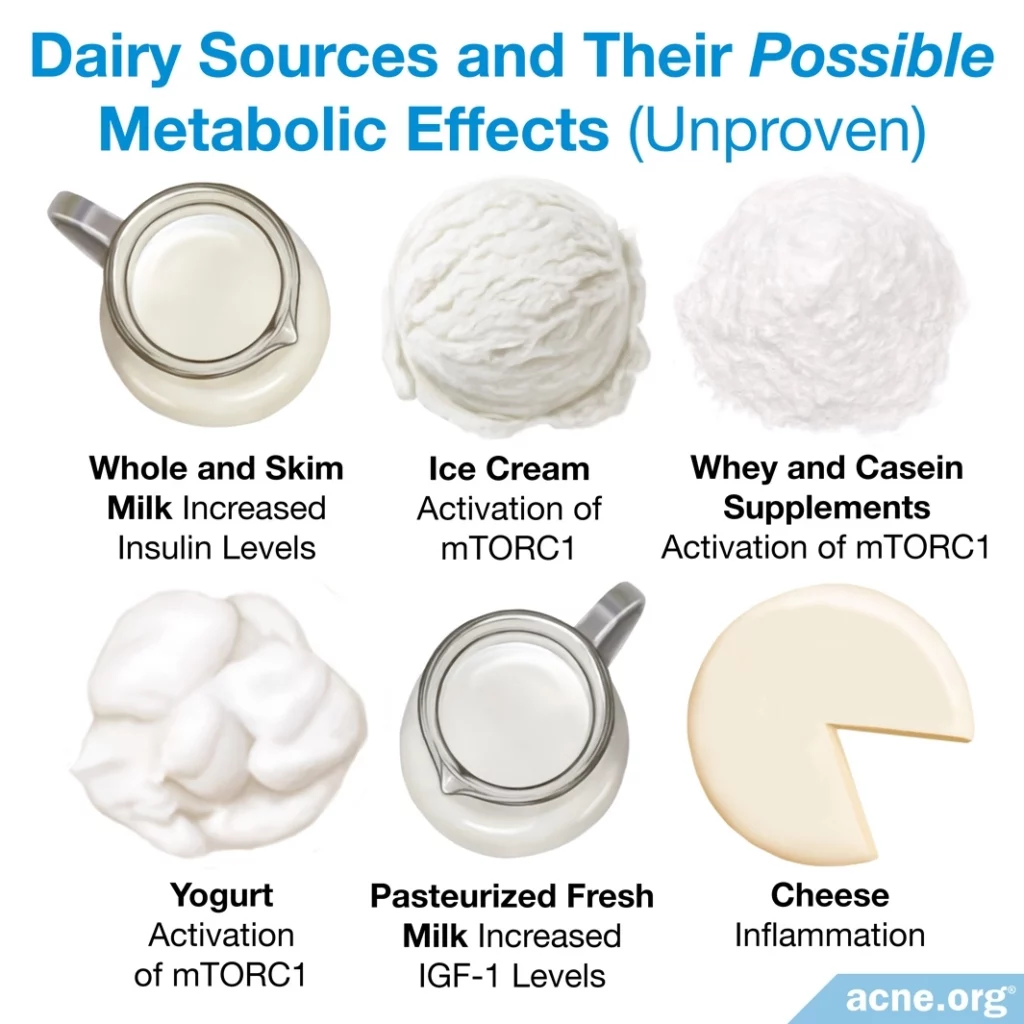
“Metabolism” describes the chemical processes that occur in the body to help it survive and function appropriately. Certain foods can boost your metabolism, while some types of foods can slow it down.
These chemical processes happen when hormones send messages and signals throughout the body. In addition to helping the body function properly, certain messages or signals might also contribute to acne formation.
The above chart displays some milk and dairy products and how they might affect the body’s metabolism. Recall from the discussion above that the hormones insulin and IGF-1 and the protein mTORC1 can lead to acne formation.3 Inflammation is also considered to be a major cause of acne.
The Bottom Line
Although researchers have not established a causal link between dairy and acne, you might find it beneficial to see if limiting dairy intake (milk in particular) improves your acne. Don’t stress out about it too much since there is not enough evidence to compel us to eliminate dairy in order to reduce acne, but it could be an interesting experiment if you’d like to try it.
Keep in mind that if, by eliminating dairy, you end up reducing calories, it may simply be the reduction in calories that temporarily helps to reduce your acne.
References
- Kucharska, A., Szmurlo, A. & Sinska, B. Significance of diet in treated and untreated acne vulgaris. Postepy Dermatol. Alergol. 33, 81-86 (2016). https://www.ncbi.nlm.nih.gov/pmc/articles/PMC4884775/
- Burris, J., Rietkerk, W. & Woolf K. Relationships of self-reported dietary factors and perceived acne severity in a cohort of New York young adults. J. Acad. Nutr. Diet. 114, 384-392 (2014). https://www.ncbi.nlm.nih.gov/pubmed/24412232
- Melnik, B. C. Linking diet to acne metabolomics, inflammation, and comedogenesis: un update. Clin. Cosmet. Investig. Dermatol. 8, 371-388 (2015). https://www.ncbi.nlm.nih.gov/pubmed/26203267
- Juhl, C. R., Bergholdt, H. K. M., Miller, I. M., Jemec, G. B. E., Kanters, J. K. & Ellervik, C. Dairy intake and acne vulgaris: A systematic review and meta-analysis of 78,529 children, adolescents, and young adults. Nutrients 10, 1049 (2018). https://www.ncbi.nlm.nih.gov/pubmed/30096883
- Aghasi, M., Golzarand, M., Shab-Bidar, S., Aminianfar, A., Omidian, M. & Taheri, F. Dairy intake and acne development: A meta-analysis of observational studies. Clin. Nutr. 38, 1067-1075 (2019). https://www.ncbi.nlm.nih.gov/pubmed/29778512
- Heng, A. H. S. & Chew, F. T. Systematic review of the epidemiology of acne vulgaris. Sci. Rep. 10, 5754 (2020). https://www.ncbi.nlm.nih.gov/pubmed/32238884
- Meixiong, J., Ricco, C., Vasavda, C. & Ho, B. K. Diet and acne: A systematic review. JAAD Int. 7, 95-112 (2022). https://pubmed.ncbi.nlm.nih.gov/35373155/
- Burris, J. Rietkerk, W. & Woolf, K. Acne: the role of medical nutrition therapy. J. Acad. Nutr. Diet. 113, 416- 430 (2013). https://www.ncbi.nlm.nih.gov/pubmed/23438493
- LaRosa, C. L, et al. Consumption of dairy in teenagers with and without acne. J. Am. Acad. Dermatol. 75, 318-322 (2016). https://www.ncbi.nlm.nih.gov/pubmed/27241803
- Cerman, A. A., et al. Dietary glycemic factors, insulin resistance, and adiponectin levels in acne vulgaris. J. Am. Acad. Dermatol. 75, 155- 162 (2016). https://www.ncbi.nlm.nih.gov/pubmed/27061046
 Acne.org Products
Acne.org Products